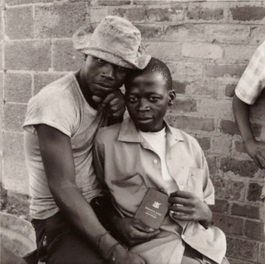This summer I’ve been helping to facilitate Family Art Lab, a weekend program at the Getty Center that combines a gallery exploration with hands-on art making in the Museum Courtyard. Through September 2, we’re offering a two-part experience centered around a monumental vase covered with casts of unusual items such as feathers, branches, ribbons, and snails. Families look at and talk about the vase, then return to the art-making tables for their own hands-on exploration of form and surface ornament.

Lots to discover: Vase, 1889, Jean-Désiré Ringel d’Illzach. Bronze and copper, 107 1/2 in. high. The J. Paul Getty Museum, 2010.2
At nine feet tall and 493 kilograms, the towering object always inspires interesting conversations—especially with kids, who have keen powers of observation and are unafraid to ask questions and even suggest how the artist might have made some improvements.
Five year-old Liam was immediately drawn to the snails and feathers on the vase, and wondered where the artist, French sculptor Jean-Désiré Ringel d’Illzach, got them. The feathers come from a peacock and were cast from real specimens, as were the snails.

Cast-bronze snails crawl upward from the base of Jean-Désiré Ringel d’Illzach’s monumental vase
Another five year-old participant, Sasha, pointed out the vase’s distinctive form and suggested that since it is hollow, it might be nice to fill it with olive oil “like the Greeks did.” Her observation was an astute one, for the vase draws its form from an ancient Greek krater in the Naples Archaeological Museum that d’Illzach sketched while touring Italy in his 20s. D’Illzach made his creation for the 1889 World’s Fair, an event that displayed all things oversized and cutting-edge, including the Eiffel Tower. (By the way, if this gigantic vase actually held oil, it would top off at well over 400 gallons.)

Lookk up…wayyy up! Sasha and her mom, Natalya, scout for details on the oversize vase.
Four year-old Catherine was the first to comment on the ornate handles, or as she described them, “something like handles.” The artist took the form of the volute (scroll-formed) krater—like this one at the Getty Villa—to towering new heights, transforming a functional element into something utterly fanciful.
Some older kids gravitated toward the ambiguous forms on the vase and enjoyed suggesting their own interpretations. Seven year-old Mauricio, Jr. was drawn to the stars that create a pattern over entire panels of the vase, giving it a celestial air. He also pointed to some of the undefined shapes and, with a smile, said they looked like chicken feet. And why not? Ringel d’Illzach was associated with the Symbolist movement, which prized subjectivity over reason, and he included a wide range of dreamlike imagery, such as bats, hippocamps (horses with fishy tails), and even blobs of cast wax that are as open to interpretation as clouds in the sky.
The vase-inspired Family Art Lab runs through September 2. Drop by the art-making tables outside the Family Room from 11:00 a.m. to 3:00 p.m. to get started, then come to the galleries with us and tell us what you see!

Faces adorn the bases of the fantastically oversized handles on d’Illzach’s vase




Great visual experiences for the children and parents, and very informative post (with great picts!) by Marty Cha. Keep up the good work at the Family Art Lab.